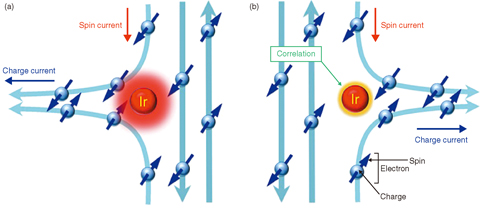
Fig.3-7 The spin Hall effect
Spintronics is a rich research field not only for the wide applications to low-energy consumption and energy transformation devices but also for the new physics of interplays amongst charge, spin, orbital angular momentum, heat, etc. The spin Hall effect (SHE), which converts the injected longitudinal charge current into the transverse spin current via the spin-orbit interactions, is crucial for the development of spintronic devices (Fig.3-7).
The SHE is characterized by the ratio between the transverse and the longitudinal resistivities, called the spin Hall angle (SHA). The magnitude of SHA describes the conversion efficiency between the charge current and the spin current, whereas the sign of SHA distinguishes the scattering direction of electrons, i.e., clockwise or anticlockwise in the transverse direction.
The SHA of CuIr alloys was measured to be a small positive value in an experiment, whereas previous theories could not consistently reproduce the positive sign. Such a discrepancy inspired us to find the key physics that decide the sign of SHA. To numerically simulate the local correlation effects, we develop two specific combined methods using density functional theory (DFT) and the quantum Monte Carlo method (QMC). First, we calculate a mixing between the base material, Cu, and the impurity, Ir, via DFT, which includes the character of the material. Next, assuming the Anderson impurity model, the mixing and the correlation is solved using QMC. Using this combined method, we find that the sign of SHA changes from negative to positive with increasing magnitude of correlation.
These theoretical results are qualitatively consistent with those of the experiment, revealing the key physics that the local correlation effects are decisive on the sign of SHA in CuIr alloys. The sign of SHA of CuIr is sensitive to perturbation of the local correlations, which is favorable for the prospect of controlling the sign of the transverse spin Hall voltage, as illustrated in Fig.3-7. This may open up a way to devise a spin current switch or a spin current sensor. Furthermore, our result will be useful for the study of spin thermoelectric generation, wherein a simple bilayer of metal and magnets is used. This will contribute to the energy efficiency.